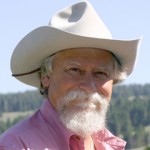Jim Arnosky’s nature illustrations first appeared in magazines when he was only 19. By the age of 26, he had illustrated his first children’s book. “I’ve never made any money doing anything else,” he says. Forty-two years, 125 books, and millions of copies later, Arnosky still writes and draws for children, refusing all work that interferes with his daily nature study. Together, he and his wife Deanna will pack up and leave their Vermont farm at a moment’s notice if they observe a specific weather pattern in Florida. “All the alligators, crocodiles, and snakes are moving,” he says.
Arnosky and Deanna live their lives in tune with the rhythms and patterns of nature.
As a child, Arnosky remembers spending whole days outdoors, sometimes shoeless. “My father was an alcoholic and my mother’s life was centered around the problems he caused.” Those moments in the woods solidified Arnosky’s identity relative to the woods and the animals; he understood the animal forced out of the nest to grow up alone. Once he remembers burying a tin treasure box in a sandy shoal of a creek bed with high banks and greenery on either side. All of a sudden, “a deer running at speed leaped over me. I remember looking up and seeing the white underside of the deer.”
Although his love of nature was the result of many solitary rambles, he says the “art was born in me.” Arnosky remembers his father’s near genius as a mechanical draftsman. “He drew machines knowing how they worked. Later when I met Roger Tory Peterson [of the Peterson bird guides] he asked me if I had an engineering background [because] he could see I understood how a bird’s wing worked, how hair works on an animal, how the bills are attached to birds. It’s all nature’s engineering and I was sort of born into it. I never had an art lesson—ever.”
After a stint in the U.S. Navy, Arnosky and Deanna moved to Hawk Mountain in Pennsylvania. They purchased a small cabin with one electrical line and a phone line, but no running water. “It was a four-and-a-half-year adventure,” Arnosky says. He read 23 volumes of American naturalist John Burroughs’ works, and began reading Henry David Thoreau. Although both Thoreau and Arnosky lived in rustic cabins, their experiences were not the same. Where Thoreau lived a solitary life, Arnosky had two daughters and a wife to provide for.
Without intending to duplicate Thoreau’s experience, Arnosky wrote his Walden thanks to long-time editor, Margaret Frith, who suggested he start writing because he knew so much about the animals he drew. Arnosky had already convinced himself that he was not a writer, so she suggested he write a letter because he frequently sent her beautiful letters about the cabin. He began, “Dear Margaret: Hi. My name is Crinkleroot. I was born in a tree and raised by bees. I can whistle in 100 languages, and I speak caterpillar, turtle, and salamander all at once…” After removing the salutation and closing, Frith published Arnosky’s first book as both author and illustrator, I Was Born in a Tree and Raised by Bees (Simon & Schuster, 1988).
When Arnosky undertakes a new project, he and Deanna travel to the animals’ native habitat and enter the rhythm of their daily lives. Deanna photographs the animals. Arnosky sketches them. Additionally, they spend hours capturing sound, movement, and ambient air on video. “Video is an intense form of seeing,” he says. “I drink in all of the experiences in a deeper way.”
While they captured images for Shimmer and Splash: The Sparkling World of Sea Life, Arnosky and Deanna worked as a well-oiled team: he caught the fish he wanted to include in the book; Deanna photographed each fish immediately after it was caught because the fish was “lit”—all its colors had risen to the surface; then they released it. Arnosky says catching the fish imparts its physical sense—how powerful it feels, how it moves—and he paints from these experiences.
Sometimes Arnosky’s experiences take a while to percolate before they become fodder for a book. Once he and Deanna saw a small band of wild burros come to a lake to drink. “There was a little one with them, and I wondered if this was the first time he’d seen the lake,” Arnosky says. But ten years passed before the words of the story solidified into Little Burro’s Favorite Place, an upcoming release.
Arnosky has learned a few things in his vast experience. By now he’s figured out that water helps his writing. Whether he stands in a stream to cast his fly-fishing line or paddles his canoe, water makes the words flow. The words could easily become a picture book or the lyrics to one of Arnosky’s many songs.
“I’ve chosen to live a certain way and be with my subjects,” Arnosky says. His nature study requires an enormous commitment. When he won the Christopher Medal forDrawing From Nature, he missed the ceremony because the trip would have required unplugging himself from the natural world. “I don’t make my books for awards committees and good reviews; I make my books for [my readers]. I have as much fun making them as they have reading them.”


